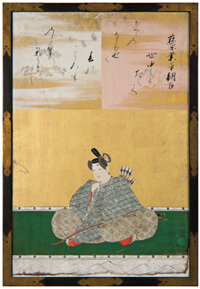

Japan originally lacked calcium in the soil and could not obtain calcium from vegetable and water like European countries. To overcome the problem, portable and preservable seaweed was appreciated and taken into their diet.
Hijiki thought to be consumed since Yayoi era (100-200AC). What believed to be hijiki was found in piece of pottery Ryugado cave in Kochi prefecture.
 Ariwara no Narihira
Ariwara no NarihiraIt first appeared on a publication on "Tales of Ise" published during early Heian period (Around 880 A.C). On a third paragraph, "Ariwara no Narihira" read a poem sending hijiki to his lover.
"Tales of culinary", a cooking book published on 1643A.C-1644A.C, stir-fried dish and marinated dish can be found for usage of hijiki. This is exactly the same usage as modern day and haven't changed since 350 years ago.